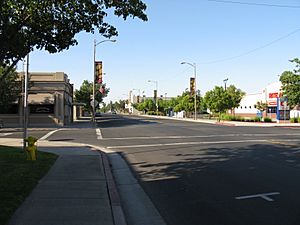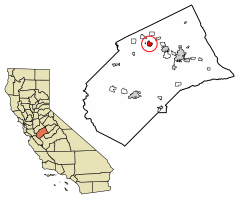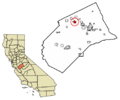Livingston, California facts for kids
Quick facts for kids
City of Livingston
|
|
|---|---|

Downtown Livingston in 2009
|
|
| Motto(s):
The Last Stop
|
|

Location in Merced County, California
|
|
| Country | |
| State | |
| County | Merced |
| Incorporated | September 11, 1922 |
| Government | |
| • Type | Council–manager |
| Area | |
| • Total | 3.678 sq mi (9.53 km2) |
| • Land | 3.675 sq mi (9.52 km2) |
| • Water | 0.003 sq mi (0.008 km2) 0.08% |
| Elevation | 131 ft (40 m) |
| Population
(2020)
|
|
| • Total | 14,172 |
| • Density | 3,856.3/sq mi (1,488.9/km2) |
| Time zone | UTC-8 (Pacific (PST)) |
| • Summer (DST) | UTC-7 (PDT) |
| ZIP code |
95334
|
| Area code(s) | 209 |
| FIPS code | 06-42006 |
| GNIS feature ID | 1656135 |
Livingston is a city located in Merced County, California, in the United States. It's about 7 miles (11 km) west-northwest of Atwater. The city sits at an elevation of about 131 feet (40 meters) above sea level.
In 2020, the city's population was 14,172 people. This was an increase from 13,058 people in 2010. Livingston covers a total area of about 3.7 square miles (9.6 square kilometers). This area includes some undeveloped farmland that was added for future growth.
Contents
Where is Livingston Located?
Livingston is found in the northern part of Merced County. It is located at coordinates 37°23′13″N 120°43′25″W. The city is slightly uphill from where the Southern Pacific Railroad crosses the Merced River. Highway 99 runs through the town, following the railroad tracks.
A Brief History of Livingston
The Livingston post office first opened in 1873. It closed for a short time in 1882 but reopened in 1883. The town was named after Dr. David Livingstone. He was a famous Scottish explorer of Africa in the late 1800s. There was a mistake on the town's post office application, which is why the spelling of the town's name is different from his.
Farming and Agriculture
Livingston is located in the very fertile San Joaquin Valley. Like the rest of this valley, it has long, dry summers. Because of this, farming here relies on irrigation (bringing water to crops). The winters are mild, with a mix of fog, rain, and sunshine. Sometimes there is a little frost.
The growing season for crops is long in Livingston. There is also a low risk of mold, drought, or bad weather harming the crops. The soil in Livingston is quite sandy. This is different from most of the valley, which has clay-based soils. This sandy soil is great for growing sweet potatoes and grapes. Almonds are also a common crop in the spring.
Livingston and Merced County are a big center for the agriculture industry. The largest businesses in Livingston are related to farming. For example, Foster Farms is the biggest poultry (chicken and turkey) producer in the western United States. Joseph Gallo Farms is a dairy that owns the largest dairy herd in the United States.
About 90% of the sweet potatoes grown west of the Rockies come from Livingston and the surrounding area. These sweet potatoes grow well because of the sandy soil. Grapes are also widely farmed near Livingston. They are used to make wine, raisins, and table grapes (grapes you eat). E & J Gallo Winery has a large grape-pressing facility just outside the city.
You will also see many almond orchards around Livingston. The Central Valley is very important for California's almond production. California produces all of the almonds used in the US and 80% of the world's supply! Other crops grown in smaller amounts include alfalfa, corn, soybeans, peaches, melons, berries, and turf (grass for lawns).
Groups like the League of Independent Workers of the San Joaquin Valley and United Farm Workers are active in this area. They work to support farm workers.
Schools in Livingston
The Livingston Union School District serves about 2,400 children in and around Livingston. This district runs three elementary schools:
- Campus Park Elementary School
- Selma Herndon Elementary School
- Yamato Colony Elementary School
Most elementary-aged children can walk to their school. All three elementary schools offer programs where students learn in both English and Spanish. This helps them become good at both languages. Livingston Middle School serves students in grades 6 through 8.
Livingston High School is part of the Merced Union High School District. It serves all students from Livingston, as well as those from nearby towns like Ballico and Cressey. In the past, many students from Delhi also attended Livingston High School. However, Delhi opened its own high school in 1998. Livingston High School offers classes in Spanish and Punjabi.
Longview Mennonite School is another school in the area that serves many Mennonite students.
In the 1990s, Livingston schools were part of a discussion about Sikh students' right to wear ceremonial daggers called kirpans. These daggers are worn under clothing. In 1995, a Federal court said that students could wear the kirpan if certain safety rules were followed.
Local Newspapers
The Livingston Chronicle is a weekly newspaper. It comes out every Saturday. The Chronicle shares local news, especially about academic and sports events at Livingston High School.
Other newspapers that cover Livingston news are the Merced Sun-Star and the Modesto Bee. All three of these newspapers are owned by the McClatchy Company. The San Francisco Chronicle is also available throughout the city.
Churches and Places of Worship
Livingston and the surrounding area have many different places of worship. These include:
- St. Jude's Thaddeus, a Catholic church
- An Apostolic Assembly
- An Assemblies of God church
- A Southern Baptist church
- A Church of Christ
- Lutheran and United Methodist churches
- A Mennonite church
- A United Pentecostal Church
- Two Sikh Gurdwaras
Who Lives in Livingston?
| Historical population | |||
|---|---|---|---|
| Census | Pop. | %± | |
| 1930 | 803 | — | |
| 1940 | 895 | 11.5% | |
| 1950 | 1,502 | 67.8% | |
| 1960 | 2,188 | 45.7% | |
| 1970 | 2,588 | 18.3% | |
| 1980 | 5,326 | 105.8% | |
| 1990 | 7,317 | 37.4% | |
| 2000 | 10,473 | 43.1% | |
| 2010 | 13,058 | 24.7% | |
| 2020 | 14,172 | 8.5% | |
| U.S. Decennial Census | |||
Livingston is a city with a very diverse population. People from many different countries and backgrounds live here.
A Mix of Cultures
The people of Livingston come from many different places around the world. This makes the city a rich mix of cultures.
- Many residents have ancestors from Mexico, including places like Michoacán, the Yucatán, Chihuahua, Veracruz, Sinaloa, Jalisco, and Oaxaca.
- People from Central America also live here, including those from Guatemala, El Salvador, and Honduras.
- Some residents are from Oklahoma and other parts of the USA. About 100 members of the Cherokee Nation live in Livingston.
- There are people from Portugal, including those from the Azores, Angola, and Brazil. About 10% of locals speak Portuguese.
- Many Hindus, Sikhs, and Muslims from India and Pakistan call Livingston home. Livingston has one of the largest communities of Sikhs in the United States.
- You'll find Japanese residents, mostly from Wakayama. The Livingston Farmers' Association was even started by Japanese Americans.
- There are Mennonites whose families came from Germany and Russia.
- People from Armenia in the Middle East have also settled here.
- Many Hmong people from Laos and Vietnam live in Livingston.
- There are also Cambodians from Cambodia.
- After the Vietnam War, many Vietnamese from South Vietnam moved to Livingston.
- You'll also find Filipinos and Chinese residents.
It's estimated that people from about 30 European, 25 Asian, 15 Latin American, and 5 Sub-Saharan African countries live in Livingston. There are very few African-Americans in the city. New immigrants continue to arrive, mostly from Mexico, Central America, Southeast Asia, the Middle East, and the Punjab.
Population in 2020
In 2020, Livingston had a population of 14,172 people. The table below shows the racial and ethnic makeup of the city over the years.
| Race / Ethnicity | Pop 2000 | Pop 2010 | Pop 2020 | % 2000 | % 2010 | % 2020 |
|---|---|---|---|---|---|---|
| White alone (NH) | 1,065 | 1,039 | 930 | 10.17% | 7.96% | 6.56% |
| Black or African American alone (NH) | 62 | 60 | 95 | 0.59% | 0.46% | 0.67% |
| Native American or Alaska Native alone (NH) | 34 | 37 | 52 | 0.32% | 0.28% | 0.37% |
| Asian alone (NH) | 1,487 | 2,193 | 2,978 | 14.2% | 16.79% | 21.01% |
| Pacific Islander alone (NH) | 3 | 16 | 19 | 0.03% | 0.12% | 0.13% |
| Some Other Race alone (NH) | 51 | 28 | 34 | 0.49% | 0.21% | 0.24% |
| Mixed Race/Multi-Racial (NH) | 250 | 138 | 128 | 2.39% | 1.06% | 0.9% |
| Hispanic or Latino (any race) | 7,521 | 9,547 | 9,936 | 71.81% | 73.11% | 70.11% |
| Total | 10,473 | 13,058 | 14,172 | 100% | 100% | 100% |
In 2010, the population was 13,058 people. About 40.3% were White, 0.8% African American, and 17.0% Asian. A large portion, 73.1%, were Hispanic or Latino. Most people lived in households, with very few in group living situations.
There were 3,156 households in 2010. Many households (63.8%) were married couples. About 15.9% had a female head of household with no husband present. The average household had 4.14 people. The median age in Livingston was 27.4 years old.
In 2000, the population was 10,473 people. The racial makeup was 36.52% White, 0.74% African American, and 14.45% Asian. Hispanic or Latino people made up 71.81% of the population. The median age was 25 years. The average household size was 4.37 people.
Sister City
Livingston has a special connection with a city in Japan.
 - Oga, Akita Prefecture, Japan
- Oga, Akita Prefecture, Japan
Images for kids
See also
 In Spanish: Livingston (California) para niños
In Spanish: Livingston (California) para niños





